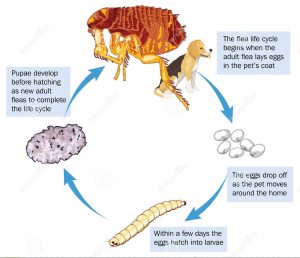
Fleas, ticks. If you have a pet, you will at some point here about these parasites that may affect the health and comfort of your pet, young or adult. They are in fact, quite a common topic we discuss at the Gisborne Vet Clinic. With such a large assortment of products available, our reception and nursing staff have an array of knowledge that can help you decide on the best treatment for your pet.
As fleas are in the environment around us, they will often attach themselves to a host as soon as they find the appropriate one. Fleas require to feed for growth and reproduction, so as they are finding hosts suitable for their lifestyle, we find our pets scratching more. When a pet begins to scratch, it can often be from the irritation caused by a flea bite. Some dogs can have, or even develop, a reaction to flea saliva. This is referred to as flea allergy dermatitis and causes further irritation. Studies have found that approximately 97% of fleas will feed within 1 hour of attaching to a host, with a single female flea consuming 15x her own weight in a day.
Fleas can be hard to see, but if you part the hair on your animal, on occasion you may see one moving around. They will also leave flea dirt (faeces), which if you place a dampened tissue on the suspected area, it should appear a red color on the tissue. This is actually digested blood from the host.
Depending on the life cycle stages of ticks, they can be found in parts of the environment or on a host. Ticks will also bite once they have found a suitable host. They will insert their mouth pieces into the skin of the host to gain access to the blood system.
There are three types of ticks that are found in Australia. Brown dog tick, bush tick and the paralysis tick. It is very difficult to identify which tick may have attached itself to your pet, but it is important to ensure it is removed appropriately by gentle methods.
If you are unsure of how to look for ticks on your pet, next time you pop into the clinic, ask our staff for a demonstration on “Timmy the tick dog”.
Although brown dog ticks and bush ticks may attach themselves to your pet, they usually are not a major concern and can be removed without any issues. If you do remove a tick and your pet becomes lethargic or shows abnormal behavior, it is recommended to organize a check-up with your vet.
Paralysis ticks can have a different effect on your pet, hence the name. They can cause serious problems and require immediate attention. Usually the first indication of your pet having a paralysis tick is the paresis. In this case, your pet may need treatment from a specialist and will need to go to your closest emergency center.
If you have any concerns about fleas and ticks effecting your pet, drop into the clinic to chat with our staff or call us on (03) 54282805.




